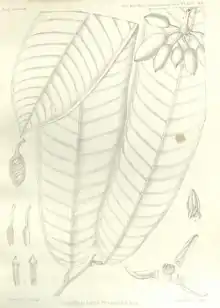| Goniothalamus uvarioides | |
|---|---|
 | |
| Botanical illustration of Goniothalamus uvarioides.[1] | |
| Scientific classification | |
| Kingdom: | Plantae |
| Clade: | Tracheophytes |
| Clade: | Angiosperms |
| Clade: | Magnoliids |
| Order: | Magnoliales |
| Family: | Annonaceae |
| Genus: | Goniothalamus |
| Species: | G. uvarioides |
| Binomial name | |
| Goniothalamus uvarioides | |
| Synonyms | |
|
Goniothalamus pendulifolius Ridl. | |
Goniothalamus uvarioides is a species of plant in the family Annonaceae. It is native to Peninsular Malaysia and Thailand.[2] George King, the British botanist who first formally described the species, named it after its fruit which he thought resembled those of the genus Uvaria more than those of Goniothalamus.[3]
Description
It is a bush reaching 1.8 to 4.6 meters in height. Its petioles are 1-3.5 centimeters long and have a channel. Its oblong to oval, somewhat leathery leaves are 32-48 centimeters long with minute wedge-shaped bases. Its leaves have 22-35 pairs of secondary veins emanating from their midribs that arch to meet one another at the leaf margins. Its flowers are on pedicels that are 1-1.6 centimeters long. Its leathery, rounded sepals are 1.2-1.6 centimeters long and covered in fine hairs. Its flowers have 6 petals in two rows of three. The very leathery, yellow, broad, lance-shaped outer petals are 3.8 centimeters long with thickened bases. The very leathery, yellow, broad, lance-shaped inner petals are 2.5-3 centimeters long with contracted at bases. Its flower have stamen with connective tissue between the lobes of the anthers that extend upward to form a conical apex. Its flowers have carpels with hairy ovaries, cylindrical styles and small stigma with a cleft. Its oblong, hairy fruit are 3.1-4.4 by 1.5-1.8 centimeters with tapering tips and bases. The fruit have 4-5 wrinkled seeds that are 1.3 centimeters long. The fruit are attached to their pedicel by stipes that are 1.1-1.8 by 0.3 centimeters.[3][4][5]
Reproductive biology
The pollen of G. uvarioides is shed as permanent tetrads.[5]
Habitat and distribution
It has been observed growing in lowland forests at elevations of 100 to 450 meters.[4]
References
- ↑ King, George (1893). "Anonaceae of British India". Annals of the Royal Botanic Garden, Calcutta. 4: plate 143. Retrieved June 15, 2020.
- ↑ "Goniothalamus uvarioides King". Plants of the World Online. The Trustees of the Royal Botanic Gardens, Kew. n.d. Retrieved February 3, 2019.
- 1 2 King, George (1892). "Materials for a Flora of the Malay Peninsula". The Journal of the Asiatic Society of Bengal. 61 (pt.2:no.1, 3): 1–130.
- 1 2 Saunders, Richard M. K. (2003). "A synopsis of Goniothalamus species (Annonaceae) in Peninsular Malaysia, with a description of a new species". Botanical Journal of the Linnean Society. 142 (3): 321–339. doi:10.1046/j.1095-8339.2003.00177.x. ISSN 1095-8339.
- 1 2 Saunders, Richard M. K.; Chalermglin, Piya (2008). "A synopsis of Goniothalamus species (Annonaceae) in Thailand, with descriptions of three new species". Botanical Journal of the Linnean Society. 156 (3): 355–384. doi:10.1111/j.1095-8339.2007.00762.x. ISSN 0024-4074.